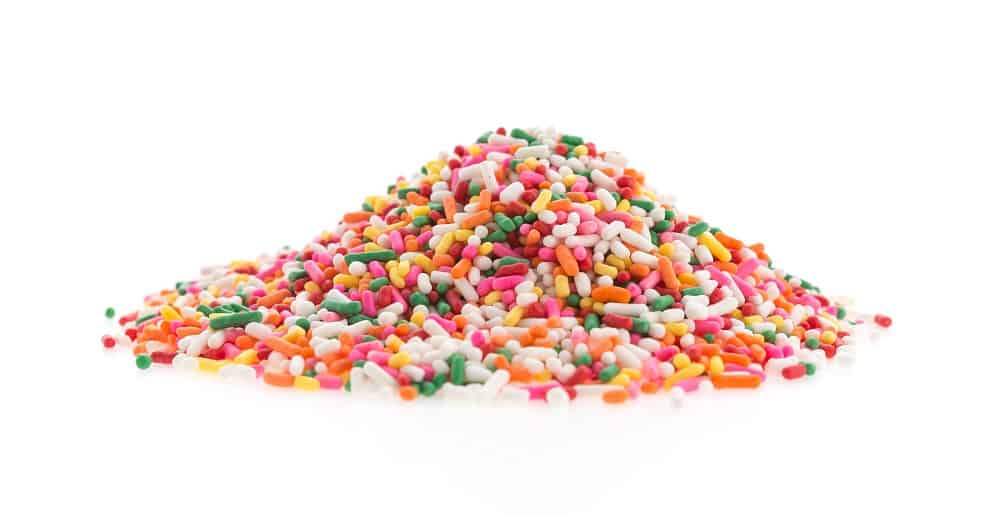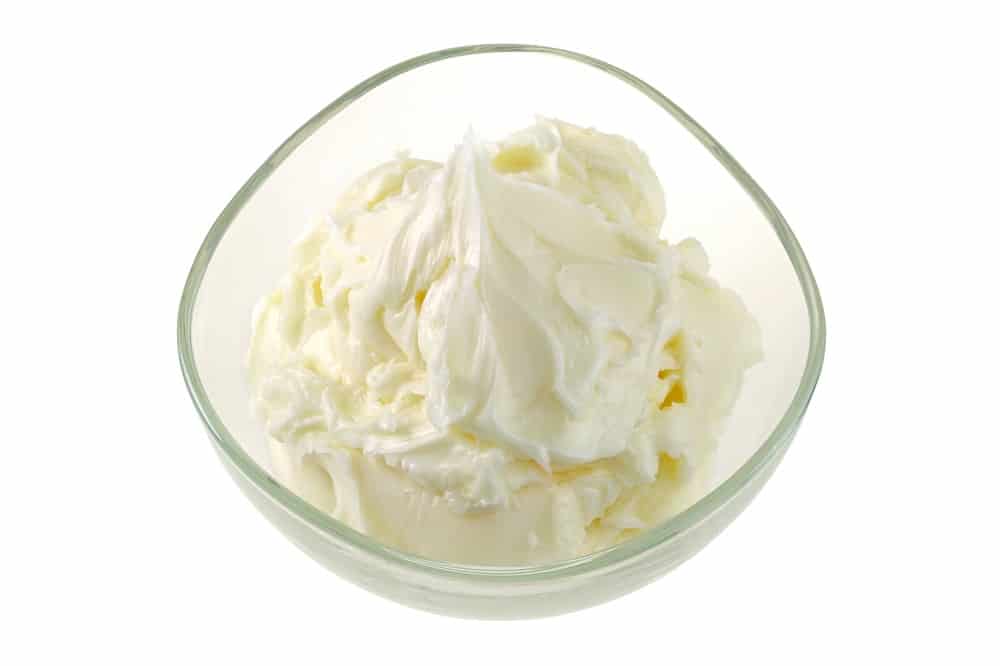Many people around the world enjoy sprinkles on their desserts as a topping. These tiny pieces of confectionery provide a few added benefits such as a fun aesthetic, a more robust texture, and even added flavor.
While it may be difficult to be sure due to the different ingredients manufacturers use, it is safer to assume that sprinkles are not vegan. As confectionery, sprinkles are mostly made of sugar. However, they can also be treated with confectioner’s glaze that can contain shellac – a resin obtained from an insect. Furthermore, sprinkles can also be made with problematic ingredients such as shortening, sugar, food coloring additives, and natural flavors.
Table of Contents
Sprinkles

Sprinkles are tiny pieces of confectionery typically used to provide aesthetic decoration and texture to desserts (e.g., cupcakes, doughnuts, ice cream, cakes, brownies, etc.). Typically coming in a wide variety of bright colors, they effectively provide a fun and celebratory decorative element to sweet desserts (1).
While different manufacturers might have different specific protocols, the production of sprinkles is generally similar from one factory to the next.
First, shortening (a common ingredient in pastries baked foods) is placed in a mixer with water. The mixer is allowed to operate for about five to ten minutes to completely mix the ingredients.
In a different mixer, powdered sugar is added with a food coloring additive. The solution of water and shortening is then added to the dry mix and the mixer makes sure all the ingredients are homogenized together.
Given around 15 to 20 minutes to operate, the result is an evenly colored dough.
The freshly made dough is then placed in conveyor belts that eventually reach an extruder designed with tiny holes. The extruder pushes the colored dough into the tiny holes to produce long narrow strands of dough that fall onto another conveyor belt. For these processes to produce standardized products, certain parameters (e.g., temperature, humidity, etc.) in the room are kept constant.
With the specific parameters of the room, the strands of dough eventually dry and reach a holding tank where they wait until they are placed in a tumbler. The constant rotation of the tumbler breaks the strands of dough into smaller pieces. The tumbler is allowed to operate for about 10 minutes until they reach the desired lengths.
In the tumbler, carnauba wax and confectioner’s glaze are added to seal the color. This prevents the colors of the sprinkles to leach when they are placed in moist frostings and creams.
After tumbling, the sprinkles are then transferred to a shaking sieve where only the sprinkles of a certain size are allowed to go through. This step serves as quality control to make sure sprinkles are all correctly sized. The sprinkles that pass through the sieve are then collected and stored.
Sprinkles can be sold in single colors. However, many manufacturers also prepare mixed sprinkles in a single package. Thus, different colored sprinkles are placed in a tumbler until they are all evenly mixed.
Aside from the ingredients listed above, sprinkles can also be added with natural and artificial flavors to improve the flavor profiles.
Are Sprinkles Vegan?
Unless it is specifically stated on the packaging that the sprinkles are vegan, it is safer to assume that commercial sprinkles are not vegan. Mostly made of sugar, that by itself is already a red flag. However, assuming that the manufacturers used vegan sugar, sprinkles are still added with many other problematic ingredients.
The biggest issue with sprinkles would be the confectioner’s glaze, and other problematic ingredients would include shortening, sugar, food coloring agents, and natural flavors.
Confectioner’s Glaze
Confectioner’s glaze is a common ingredient used in candies and other sweet food products to provide a shiny, smooth finish. The ingredient is also used to coat medicine and is called pharmaceutical’s glaze in the pharmaceuticals industry.
However, this ingredient cannot be considered vegan as it contains shellac, also known as beetle juice. Shellac is a resin produced from the secretions of the female lac bug (Kerria lacca) (2). Collected from the forests of India or Thailand, this resin is produced by the insects as a way to protect their soon-to-hatch eggs.
Shortening

Shortening is a general name for a fat that is used to make pastry and other food products. Shortening is typically made from vegetable oils (e.g., soybean oil, cottonseed oil, palm oil, etc.). Due to the general use of vegetable oils to make shortening, shortening is almost synonymous with vegetable shortening.
However, shortening can also be made from animal fats. Thus, shortening made from animal fats cannot be considered vegan. Unfortunately, since shortening is usually just one of many ingredients added to make a food product, it is difficult to be certain whether the shortening used was vegan or not.
Even if shortening was from a plant source, it could be from palm oil – that itself is another problematic ingredient to many vegans as palm oil is associated with human rights violations (3) and the destruction of forestland (4). This means that even if shortening made from palm oil is dietarily vegan, it might not be accepted by ethical and environmental vegans.
Sugar
Sugar is the most common sweetener used in products and it is conventionally produced from plant sources such as sugarcane. Despite coming from plant sources, sugar is typically considered a gray area ingredient amongst the vegan community because of how it is manufactured.
To appeal to the general market, sugar companies refine their to be finer and white. To achieve these properties, sugar has to undergo additional processes. One process used for sugar refinement is filtration. While some companies use vegan materials for filtration such as granular carbon, some companies use bone char – the charred skeletal remains of animals (5).
Thus, sugar produced using bone char can no longer be considered vegan as its production involves the use of an animal product. However, this issue is more common for vegans in the USA since the practice of using bone char in the sugar industry is more common in this country than anywhere else in the world.
Food Coloring Agents
The main characteristic of sprinkles is they come in different colors. This is achieved through the use of food coloring agents. While most food coloring agents used today are made without the use of animal products or derivatives, vegans find synthetic food coloring additives to be highly problematic as these substances undergo numerous animal testing.
Coming in a wide variety of colors, sprinkles can be made with the use of popular food color additives such as Red 40, Blue 1, or Yellow 5. These are all synthetic food ingredients that are approved by the FDA (Food and Drug Administration) for human consumption (6).
However, these food coloring additives all had to undergo animal testing to become certified by food safety authorities such as the FDA and EFSA (European Food Safety Authority). Animal testing is seen as a highly unethical practice by numerous animal rights groups including ethical vegans because animal testing studies typically subject animals to inhumane conditions.
Furthermore, animal testing is supposedly unnecessary in today’s modern era where other research techniques such as using cell models and in silico studies (i.e., the use of computer models and algorithms) can effectively replace the use of animal models.
Natural Flavors
Natural flavors is a common ingredient in many products and is a way for companies to protect their proprietary blend that gives their products their distinct flavor. However, the problem with natural flavors lies with its FDA definition. As stated, the FDA defines natural flavors as:
“The essential oil, oleoresin, essence or extractive, protein hydrolysate, distillate, or any product of roasting, heating or enzymolysis, which contains the flavoring constituents derived from a spice, fruit or fruit juice, vegetable or vegetable juice, edible yeast, herb, bark, bud, root, leaf or similar plant material, meat, seafood, poultry, eggs, dairy products, or fermentation products thereof, whose significant function in food is flavoring rather than nutritional (7).”
FDA.gov
That said, it is difficult to identify if whether a product with natural flavors is vegan or not since the definition of natural flavors encompasses both plant and animal sources. Unless stated on the label or by the company that the product is vegan, there is no assurance that a product with natural flavors is made without the use of animal products or derivatives.
References
2. https://www.researchgate.net/




